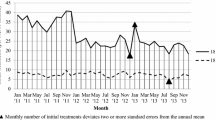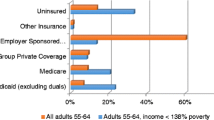Abstract
In response to increasing health expenditures and a high number of physician visits, the German government introduced a copayment for ambulatory care in 2004 for individuals with statutory health insurance (SHI). Because persons with private insurance were exempt from the copayments, this health-care reform can be regarded as a natural experiment. We used a difference-in-difference approach to examine whether the new copayment effectively reduced the overall demand for physician visits and to explore whether it acted as a deterrent to vulnerable groups, such as those with low income or chronic conditions. We found that there was no significant reduction in the number of physician visits among SHI members compared to our control group. At the same time, we did not observe a deterrent effect among vulnerable individuals. Thus, the copayment has failed to reduce the demand for physician visits. It is likely that this result is due to the design of the copayment scheme, as the copayment is low and is paid only for the first physician visit per quarter.




Similar content being viewed by others
Notes
In the absence of WHO data for Germany, we have used data on the number of physician contacts, provided by the German Socio-Economic Panel (SOEP) for the year 2006. According to a study based on claims data from one of the largest German sickness funds, the average person in Germany makes as many as 16.3 physician visits annually [2].
One would assume that with the introduction of copayments in the SHI, individuals who can opt for the PHI showed a higher probability to switch to the PHI. However, the PHI attracted even fewer new members in 2004 than in previous years [15].
References
GEK-Gmünder Ersatzkasse: GEK-report ambulant-ärztliche Versorgung. Auswertungen der GEK-Gesundheitsberichterstattung. Asgard, Sankt Augustin (2006)
World Health Organization (WHO): Health for all database. WHO, Geneva (2008)
Busse, R., Riesberg, A.: Health care in transition profile, Deutschland. European Observatory on Health Care Systems, Kopenhagen (2005)
Deutscher Bundestag: Entwurf eines Gesetzes zur Modernisierung der Gesetzlichen Krankenversicherung (GKV-Modernisierungsgesetz). Drucksache 15/1525, Berlin 8.9.2003
Federal Ministry of Health (Bundesministerium für Gesundheit): Gesetzliche Krankenversicherung. Mitglieder, mitversicherte Angehörige, Beitragssätze und Krankenstand. Bonn, Bundesministerium für Gesundheit, Berlin. (2007)
Association of Private Health Insurance [Verband der Privaten Krankenversicherer (PKV)]: Die private Krankenversicherung. Zahlenbericht 2006/2007. PKV, Köln (2007)
Cherkin, D.C., Grothaus, L., Wagner, E.H.: The effect of office visit copayments on preventive care services in an HMO. Inquiry 27, 24–38 (1990)
Scitovsky, A.A., McCall, N.: Coinsurance and the demand for physician services: four years later. Soc. Secur. Bull. 35, 4019–4027 (1977)
Roemer, M.I., Hopkins, C.E., Carr, L., Gartside, F.: Copayments for ambulatory care: penny-wise and pound-foolish. Med. Care 13, 457–466 (1975). doi:10.1097/00005650-197506000-00002
Beck, R.G., Horne, J.M.: Utilization of publicly insured health services in Saskatchewan before, during and after copayment. Med. Care 18, 787–806 (1980). doi:10.1097/00005650-198008000-00001
Manning, W.G., Newhouse, J.N., Duan, N., Keeler, E.B., Leibowitz, A., Marquis, M.S.: Health insurance and the demand for medical care: evidence from a randomized experiment. Am. Econ. Rev. 77, 251–277 (1987)
Elofsson, S., Unden, A.L., Krakau, I.: Patient charges—a hindrance to financially and psychosocially disadvantage groups seeking care. Soc. Sci. Med. 46, 1375–1380 (1998). doi:10.1016/S0277-9536(98)00030-6
Winkelmann, R.: Co-payments for prescription drugs and the demand for doctor visits—evidence from a natural experiment. Health Econ. 13, 1081–1089 (2004). doi:10.1002/hec.868
Wagner, G.G., Frick, J.R., Schupp, J.: The German Socio-Economic Panel Study (SOEP)—evolution, scope and enhancements. Schmoller’s Jahrbuch. J. Appl. Soc. Sci. Stud. 127, 139–170 (2007)
Association of Private Health Insurance [Verband der Privaten Krankenversicherer (PKV)]: Die private Krankenversicherung. Zahlenbericht 2004/2005. PKV, Köln (2005)
Blundell, R., Costa Dias, M.: Alternative approaches to evaluation in empirical microeconomics. Cemmap Working Papers CWP10/02. http://cemmap.ifs.org.uk/wps/cwp0210.pdf (2002). Accessed 20 Jan 2008
Zhang, J.: A DiD analysis of the impact of health insurance reform in the city of Hangzhou. Health Econ. 16, 140–1389 (2007). doi:10.1002/hec.1230
Wooldridge, J.M.: Econometric analysis of cross section and panel data. The MIT Press, Cambridge (2002)
Lostao, L., Regidor, E., Geyer, S., Aiach, P.: Patient cost sharing and physician visits by socioeconomic position: findings in three Western European countries. J. Epidemiol. Community Health 61, 416–420 (2007). doi:10.1136/jech.2006.047126
Sheu, M.L., Hu, T.W., Keeler, T.E., Ong, M., Sung, H.Y.: The effect of a major cigarette price change on smoking behaviour in California: a zero-inflated negative binomial model. Health Econ. 13, 781–791 (2004). doi:10.1002/hec.849
Yau, K.K.W., Wang, K., Lee, A.H.: Zero-inflated negative binomial mixed regression modeling of over-dispersed count data with extra zeros. Biometrica 45, 437–452 (2003). doi:10.1002/bimj.200390024
Lambert, D.: Zero-inflated Poisson regression with an application to defects in manufacturing. Technometrics 34, 1–14 (1992). doi:10.2307/1269547
Long, J.S., Freese, J.: Regression models for categorial dependent variables using Stata. Stata Press, College Station (2006)
Jones, A.M.: Health econometrics. In: Culyer, A.J., Newhouse, J.P. (eds.) Handbook of health economics, pp. 265–344. Elsevier, Amsterdam (2000)
Greene, W.: Accounting for excess zeros and sample selection in Poisson and negative binomial regression models. Stern School of Business Working Paper EC-94-10. Stern School of Business, New York (1994)
Augurzky, B., Bauer, T., Schaffner, S.: Copayments in the German health system—do they work? RWI Discussion papers. No. 43. RWI, Essen (2006)
Grabka, M., Schreyögg, J., Busse, R.: Verhaltensänderung durch Einführung der Praxisgebühr und Ursachenforschung—eine empirische Analyse. Med. Klin. 101, 476–483 (2006). doi:10.1007/s00063-006-1067-z
Rückert, I.-M., Böcken, J., Mielck, A.: Are German patients burdened by the practice charge for physician visits (‘Praxisgebühr’)? A cross sectional analysis of socio-economic and health related factors. BMC Health Serv. Res. 8, 232 (2008). doi:10.1186/1472-6963-8-232
Author information
Authors and Affiliations
Corresponding author
Appendix
Rights and permissions
About this article
Cite this article
Schreyögg, J., Grabka, M.M. Copayments for ambulatory care in Germany: a natural experiment using a difference-in-difference approach. Eur J Health Econ 11, 331–341 (2010). https://doi.org/10.1007/s10198-009-0179-9
Received:
Accepted:
Published:
Issue Date:
DOI: https://doi.org/10.1007/s10198-009-0179-9




